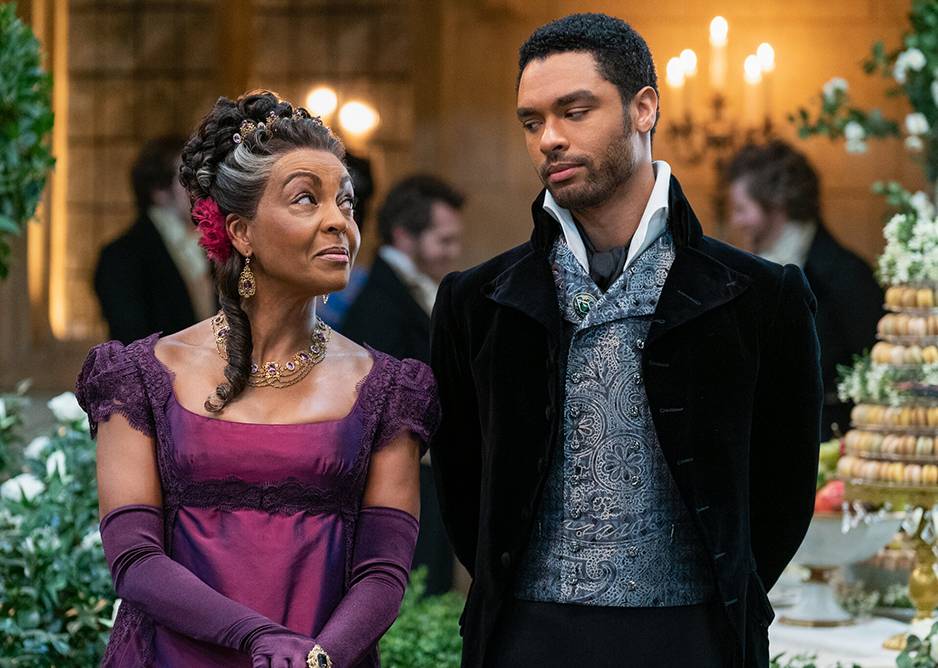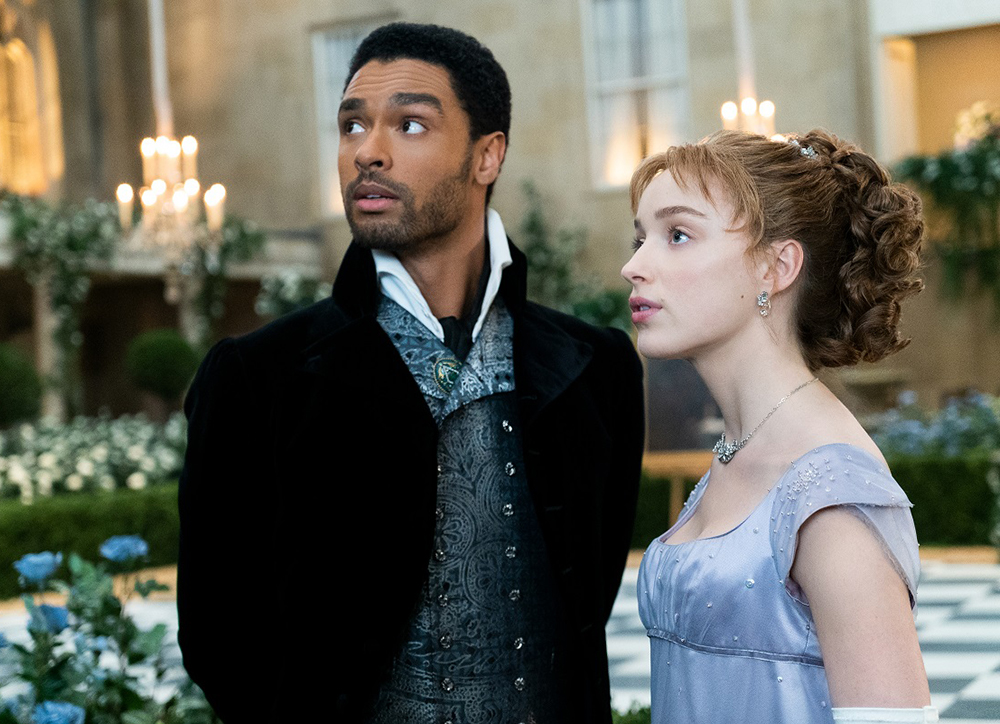Set during the Regency/Georgian era of England in 1813, and based on the novel “The Duke And I” by Julia Quinn, Netflix’ “Bridgerton” follows the powerful Bridgerton family as they try to navigate the minefield that is society during the debutant balls of the season. The family are an eclectic bunch of varying personalities, and the show boasts a whole host of amazing visuals, period costumes, intricate storylines, and overt sexuality.
When Daphne Bridgerton (Phoebe Dynevor) bumps into Simon Basset (Regé-Jean Page)—the Duke of Hastings—at a ball, the two immediately clash, but at the same time are intrigued by one another. They hatch a plot to pretend to be courting so that Daphne can escape an unsavoury suitor and Basset can avoid the attentions of other women in society. As the plot progresses we learn that Bassett had a stammer as a child and hardly spoke, much to the dismay of his father. We also learn that his father was incredibly cruel to him because of this and that his mother died in child birth. Due to this he vowed on his father’s deathbed to never marry and have an heir, and thus end his father’s line. Things turn complicated when Daphne and Simon realise they are quite fond of each other. Can love for one person conquer hate for another?
This is the backdrop which the main story is set against, but the show also boasts a host of intricate side plots and a brilliant ensemble cast to boot. Each supporting character has their own story arc fraught with twists and turns and the contrasting nature of each of the characters make the show appealing to a wide audience.
For example Daphne is seen as ‘the jewel of the town’ who everyone wants to marry; she is content to go to balls and excited by the prospect of the season. However her sister Eloise (Claudia Jessie) is more studious and has ambitions to go to university. On top of this we have the Featherington family who are used for a mixture of comic relief but also have their own deep rooted issues they need to overcome. Lord Featherington is gambling the family into ruin; his three daughters are hardly the most ‘traditional’ match, and on top of this they must find a suitor for their out-of-town cousin Marina Thompson, who is with child. “Bridgerton” is rich with scandal and gossip, containing sufficient twists and turns to leave the viewer invested and wanting more.

A common theme running throughout the show is that everyone is expected to behave a certain way, but they can’t quite live up to society’s expectations of themselves. The characters are incredibly human, fraught with their own wants, needs, and flaws which makes them extremely relatable. The story provides a platform to comment on a number of societal issues and explores a number of ideas surrounding loss, love, sexuality, and power. For example Sir Henry Granville, while married to a woman, is secretly homosexual, which shocks Benedict Bridgerton. However Granville explains his marriage affords his wife her liberty, she is looked after, happy, and has her freedom. He also explains that Benedict could never understand what its like to truly be in love with someone you can’t have, and to potentially lose your life because of it.
The show also comments on other social injustices of the time period as can be seen in “Episode 1: Diamond of the First Water” when Daphne says, “You have no idea what it is to be a woman, what it might feel like to have one’s life reduced to a single moment. This is all I have been raised for. This is all I am. I have no other value. If I am unable to find a husband I shall be worthless.”
Season one of the series also comments frequently on how patriarchal traditions have caused issues for women throughout time, and is incredibly relevant as we are still feeling the ramifications of such unjust traditions today. “Bridgerton” gives the viewer a female perspective on these issues.
“Bridgerton” is rich with scandal and gossip, containing sufficient twists and turns to leave the viewer invested and wanting more.”
As expected for a period drama, the costumes are stylish, elegant, and incredible. “Bridgerton” boasts flamboyant headpieces, beautiful ball gowns, and stunning dresses for the women, along with immaculate breeches, coats, and tails for the men. Each of the families in the show have their own colour palette that accentuates their personality. This use of costume works really well and is a great choice by costume designers John Glaser, Ellen Mirojnick, and John Norster. Likewise, the locations used for filming are truly wonderful and show off some of the beauty you can still see in England today. The costume and cinematography used are welcoming additions to the show that add an extra layer of enjoyment to it.
The score is a combination of classical music to fit the time period and orchestral covers of popular pop songs from modern day. While this choice is certainly interesting and makes the show relatable to a modern, younger audience, it does also jar slightly because it reminds us that we are watching a TV show and doesn’t suspend our disbelief as a viewer. That said, many people may find this quirky and unique use of music by composer Kris Bowers entertaining and enjoyable, and welcome the addition of contemporary pop artists such as Maroon 5 and Ariana Grande.

There is one glaringly obvious problem with the show and a huge historical inaccuracy to boot, but it is a bit of a grey area. Slavery wasn’t abolished in the UK until 1833 (20 years after the show is set) at a whopping cost of £20 million at the time. This was 40% of the governments budget in 1833 and the equivalent to £20 billion in today’s money. In fact, the cost of abolishing slavery was so high the government had to take out loans to pay reparations to slave owners; these loans were finally paid off in 2015.
Now we know this is a travesty. Slavery shouldn’t have happened but it did, and it is a stain on the history of the world. Many people have accused “Bridgerton” of downplaying the struggles of black people both during the time period and today. There is a brief two-minute scene where Lady Danbury explains the King married a black woman which changed the fortune of Black people everywhere and they became seen as equals in society. The problem is, the scene feels like an afterthought because the idea is unnaturally introduced and never mentioned again. It is of course a historical inaccuracy. On the other hand, its brilliant that the show-runners have cast the show irrespective of ethnicity and skin colour because we desperately need equal representation in the arts. It feels like it would have been more prudent to explain the situation in England during the time period at the start of Episode 1 whilst explaining the casting decision. This would have paid better homage to the struggle that Black people have faced everywhere, because at the moment it feels like the show is just breezing over it when we can’t afford to forget such injustices.
In conclusion, “Bridgerton” is an interesting take on a period drama. It’s filled with scandal, oozing sexuality, and full of hearty laughs. There is plenty to look forward to and celebrate with a show such as this, and everyone involved has done a brilliant job bringing the piece to life. It really is a modern take on a classic romance drama. Added to this the story’s explorations of love, marriage, and social standards are intriguing, interesting, and will leave you wanting more. The climax of Season 1 ties up some loose ends, but also leaves room for Season 2, which is currently under production. You can catch “Bridgerton” on Netflix now.


